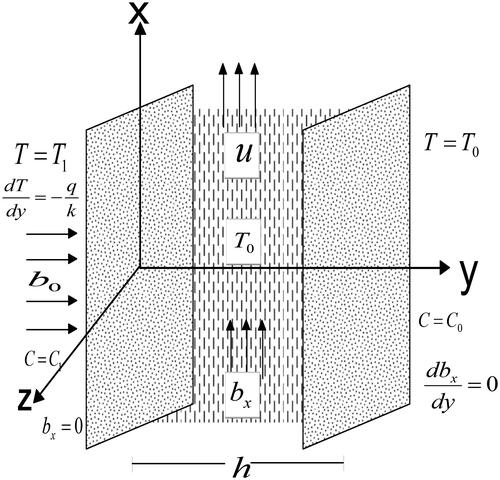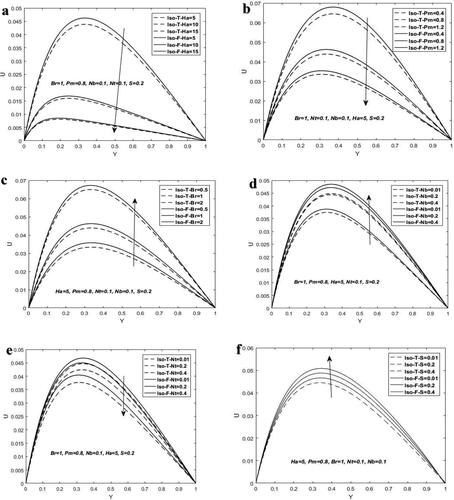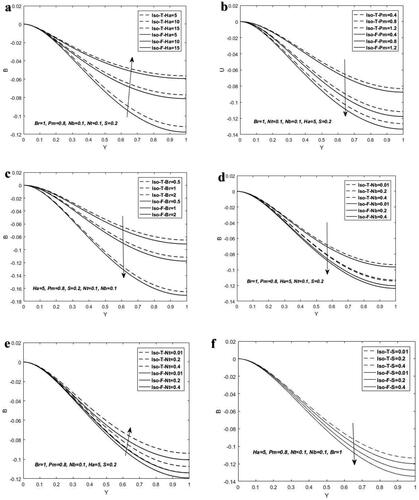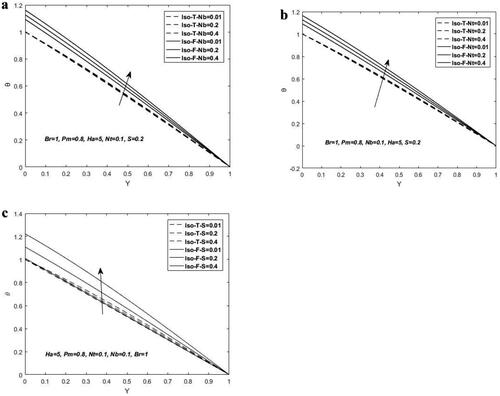 ?Mathematical formulae have been encoded as MathML and are displayed in this HTML version using MathJax in order to improve their display. Uncheck the box to turn MathJax off. This feature requires Javascript. Click on a formula to zoom.
?Mathematical formulae have been encoded as MathML and are displayed in this HTML version using MathJax in order to improve their display. Uncheck the box to turn MathJax off. This feature requires Javascript. Click on a formula to zoom.Abstract
This article presents a close form of solution to the magnetohydrodynamics free convection between two parallel vertical plates filled with nanoparticles with induced magnetic field effect. The surface of the channel is maintained at constant heat flux or constant temperature.The exact and the numerical solution is obtained through the method of undetermined coefficient and RKF45 in maple software respectively while the analytic solution is obtained through perturbation. The governing equations include the significant effects of the thermophoretic and Brownian motion parameters due to the presence of nanofluid. The role of the active parameters on the velocity, temperature, induced current density, concentration and induced magnetic field is illustrated using graphs. The results of the study showed that Brownian motion parameter Buoyancy ratio
and the heat source parameter
plays a supportive role on the velocity whereas other active parameters found to have decreasing effect on the velocity profile. Regarding the temperature distribution, the heat source parameter
Brownian motion parameter
and the thermophoretic parameter
augment enhance the nanofluid temperature. The skin friction decreases with Hartmann number
and magnetic Prandtl number
augment but increases with Buoyancy ratio
and heat source parameter
1. Introduction
The notion of suspension of nanoparticles into the base fluid was pioneered by Choi and Eastman (Citation1995). Ever since, nanofluid has witness global attention by several workers in the field biomedical science, microelectronic etc. Nanofluid is the suspension of nanoparticles (metal and nonmetal) into the base fluid. The inclusion of nanoparticles to the base fluid helps to enhance the thermal conductivity of the fluid and consequently propagates the rate of heat transfer. Garoosi, Jahanshaloo, Rashidi, Badakhsh, and Ali (Citation2015) presented a report on the close form of the solution for two-dimensional nanofluid flow considering a square cavity. They concluded that there exist a maximum volume fraction at which optimal heat transfer can be achieved. Qayyum, Khan, Hayat, and Alsaedi (Citation2017) numerically examined the general framework for chemical reactive and radiation on MHD nanofluid flow. They demonstrated that radiation plays a pivotal role on heat transfer coefficient and temperature distribution. Sheikholeslami and Chamkha (Citation2016) used a numerical approach to addreess the role of the electric field on free convection of nanofluid flow and concluded that the flow formation propagates with the growing values of voltage parameter. Bhatti and Rashidi (Citation2016) explored the combined effect of thermal and thermo-diffusion of nanofluid over a shrinking/stretching surface. Sheikholeslami and Shehzad (Citation2017) studied the radiation effect on ferrofluid flow in the presence of Lorentz force with variable viscosity. Malvandi and Ganji (Citation2015) examined the significant effect of nanoparticle concentration and asymmetric heating on MHD forced flow considering water/alumina in a microchannel. Sheikholeslami and Rokni (Citation2017) presented the impact of magnetic field on two phase nanofluid natural convection flow. Chen, He, Zhu, and Wen (Citation2016) examined the efficiency of collectors considering the silver nanofluid.
In the study of hydrodynamics natural convection, most researchers neglected the significant role of the induced magnetic field in order to simplify the mathematical model. The application of the induced magnetic field has the potential to create its magnetic field in the fluid and consequently amplifies the original magnetic field. Hence, the inclusion of the induced magnetic field effect in the hydrodynamics model becomes essential. Sheikholeslami and Ellahi (Citation2015) presented a numerical solution of three dimensional free convection nanofluid flow under the influence of Lorentz force. Kefayati (Citation2016) numerically studied an entropy generation of nanofluid in the existence of Lorentz force. Azizian et al. (Citation2014) studied the effect of the Lorentz force on laminar convection heat transfer. Kandelousi (Citation2014) presented a numerical solution of the effect of the variable magnetic field on heat transfer and ferrofluid flow. Nguyen et al. (Citation2020) designed a heat exchanger considering combined turbulator. The effect of the induced magnetic field considering different geometries has also been examined by Hayat, Waqas, Khan, and Alsaedi (Citation2016), Ibrahim and Makinde (Citation2013), Khan and Makinde (Citation2014), Makinde and Aziz (Citation2011), Mutuku and Makinde (Citation2014), Rudraiah, Barron, Venkatachalappa, and Subbaraya (Citation1995), Sheikholeslami, Ashorynejad, and Rana (Citation2016), Sheikholeslami, Gorji-Bandpy, and Domairry (Citation2013), and Sheikholeslami, Gorji-Bandpy, and Ganji (Citation2014a; Citation2014b). They proved that the increase in magnetic strength has decreasing effects on flow formation. Recent study related to the study of the induced magnetic field effect includes Cao et al. (Citation2019), Feng, Shi, Shoji, Kubo, and Tsukada (Citation2019), Mehryan, Tahmasebi, Izadi, and Ghalambaz (Citation2020), and Sarveshanand and Singh (2015). These showed that the induced magnetic field propagation decereases the induced current density and velocity profile.
In most cases, there are temperature differences between the surface and the ambient fluid. This requires the use of temperature dependent heat source. The study of heat source temperature dependent on MHD fluid flow has received tremendous attention because of its theoretical and physical importance in MHD fluid flow. Heat source temperature dependent is useful in cooling nuclear reaction, improving the quality of the final product, combustion process etc. Furthermore, heat source plays a pivotal role in neurobiology (in the study of the human brain function). Bhattacharyya (Citation2011) addressed the importance of suction/injection heat source/sink on boundary layer flow over a shrinking sheet with radiation effect and he concluded that growing the heat source parameter boosts the rate of heat transfer. Kumar and Singh (Citation2015) analyzed the role of the induced magnetic field and Newtonian heating/cooling on free convection flow in a vertical channel. Kumar and Singh (Citation2016) also addressed the combined impact of the magnetic field and heat source/sink on free convective flow. Kumar, Singh, and Sarveshanand (Citation2017) further analyzed the role of Hall current on MHD natural convection flow between two parallel plates. The effect of the induced magnetic field and hall current on MHD free convection flow has been addressed by Kumar, Singh, and Kumar (Citation2018). Kumar, Singh, and Kumar (Citation2020) investigated the combined effect of heat source/sink and Hall effects on MHD in a vertical channel. They stressed that the heat source propagation leads to the increase in the flow formation whereas decreases the induced magnetic field. Some recent studies on the effect of heat source include Alsabery, Gedik, Chamkha, and Hashim (Citation2019), Kumar, Singh, Tanwar, and Baleanu (Citation2019); Roy, Hossain, and Gorla (Citation2020), and Tlau and Ontela (Citation2019). These authors demonstrated that the velocity and the temperature distribution enhances with the intensity of the heat source.
Considering the importance of heat source in engineering and industries, it is desirable to examine its influence on MHD natural convection flow between the two vertical plates filled with nanofluid with induced magnetic field effect. The effects of other controlling parameters on the fluid transport have also been taken into consideration. The surface of the vertical channel is assumed to be heated through the isothermal or isoflux process. The close form (analytic solution) to the sets of differential equations is obtained through perturbation method by considering small thermophoretic and Brownian motion parameter using the mixed boundary conditions. Further, the perturbation result is validated through comparison with the numerical solution (by RKF45 method in maple) and exact solution(by the method of undetermined coefficient) which showed an excellent correlation.
2. Mathematical formulation
A steady magnetohydrodynamic (MHD) nanofluid flow of an electrically conducting and viscous incompressible fluid between two infinite vertical plates is considered. The distance between the two walls is taken as h. The x-axis and y-axis are assumed to be respectively vertically upward and perpendicular to the plate as illustrated in . The magnetic field of uniform strength is applied in the transverse direction of the fluid flow. The plate is assumed to be electrically non-conducting at
and electrically conducting at
The wall at
is kept at constant heat flux (isoflux case) or at a fixed temperature (isothermal case). Since the two vertical plates are of infinite extent, the variable describing the fluid transport only depend on y-coordinate. Consider an electrical conductivity
and the magnetic field along the x-axis
The velocity vectors and the magnetic field are assumed to be respectively
and
The Maxwell equations considered in the present study are:
(1)
(1)
(2)
(2)
(3)
(3)
(4)
(4)
Furthermore, the magnetic induction equation considered can be expressed as:
(5)
(5)
Utilizing the Maxwell and the magnetic induction equation above, the governing equation can be expressed as:
(6)
(6)
(7)
(7)
(8)
(8)
(9)
(9)
With boundary conditions:
(10)
(10)
The dimensionless variables related to the present study are defined as:
(11)
(11)
The dimensional parameters controlling the fluid flow are defined as:
(12)
(12)
Using EquationEqs. (11–12) in Eqn. (6–10), the dimensionless equation and the boundary condition reduces to
(13)
(13)
(14)
(14)
(15)
(15)
Where are constants defined as:
Isothermal case (Iso-T)− and
Isoflux case (Iso-F)− and
The induced density and skin friction are respectively expressed as and
2.1. Analytic solution by perturbation method
It can be observed that the energy and concentration equations (EquationEq. (14)(14)
(14) ) is independent of EquationEq. (13)
(13)
(13) . Thus, EquationEq. (13)
(13)
(13) can be evaluated after the solutions of EquationEq. (14)
(14)
(14) is developed. The degree of the Brownian and thermophoretic diffusion is negligible for nanoparticles according to Bhatti and Rashidi (Citation2016). Hence we consider
of
and expand
in a small parameter
such that;
(16)
(16)
(17)
(17)
The (
) boundary conditions are
and
respectively.
Where;
Isothermal case (Iso-T) – and
Isoflux case (Iso-F) – and
The analytic solution is expressed as
where
and
are constants defined in Appendix A.
2.2. Exact solution
The dimensionless equations are solved using the method of undetermined coefficients by isothermal boundary condition in the absence of heat source temperature dependent. The exact solution can be expressed as:
where constants
and
are defined in Appendix.
3. Results and discussion
The influence of the induced magnetic field and temperature dependent heat source on magnetohydrodynamics natural convection in a vertical channel is studied. The close form of the solution (analytic solution) is obtained by perturbation method using the unified (isothermal and isoflux) boundary conditions, while the exact and numerical solution is obtained using isothermal boundary condition. The perturbation result has been validated through comparison with the exact and numerical solution for isothermal boundary condition in the absence of heat source. The exact solution is obtained by the method of undetermined coefficient while the numerical solution is obtained using RKF45 in Maple software. RKF45 is a default method in maple software due to its robustness, good convergence, and accuracy. demonstrates the accuracy of the present solution (perturbation method). The influence of the embedded parameters like heat source parameter Hartmann number
Brownian motion parameter
Buoyancy ratio
magnetic Prandtl number
and the thermophoretic parameter
on the velocity, induced magnetic field, induced current density, temperature, and concentration for the two thermal boundary conditions are presented. The values of Ha, Nt, Pm, S, Br, and Nb covered in this study are:
and
following Sarveshanand and Singh (2015), Kumar et al. (Citation2020), and Sheikholeslami and Rokni (Citation2017).
Table 1. Comparison of the analytic, exact and numerical solutions on skin friction for the isothermal case with
illustrates the significant effect of the prominent parameters on the velocity profile for the two thermal boundary conditions. Observation from shows that the velocity profile drops with Hartmann number augment. The sudden drop in the velocity profile is due to the
fact that the induced magnetic field applied perpendicular to the channel generate a mechanical force called the Lorentz force which acts against the fluid flow. Regarding the magnetic Prandtl
and thermophoretic parameter
the flow formation enhances with increasing values of
and
as depicted in . The velocity profile is approximately parabolic in nature with its peak near the centre of the channel but for large values of
and
the velocity profile reduces to just a flat line on the surface of the channel. Therefore, the flow formation can be reduced by adding more thermophoresis particle and applying a stronger magnetic field. Heat source augment increases the velocity profile as shown in . The heat source generates more heat energy which causes the fluid temperature to increase and consequently increases the fluid velocity. It is also observed that there is no significant impact of heat source variation on the velocity profile when the isothermal boundary condition is applied at the surface of the channel. Furthermore, an increase in the values of Buoyancy ratio
and Brownian motion parameter
leads to the increase in the velocity profile.
depicts the effects of the controlling parameters on the induced magnetic field for the two boundary conditions under consideration. It is noticed in that the induced magnetic field strength is proportional to the Hartmann number due to the fact that the drag force strengthens the induced magnetic field influence. Furthermore, the induced magnetic field profile for various values of thermophoretic parameter
exhibits a similar trend with that of the Hartman number as demonstrated in . The influence of magnetic Prandtl number
Buoyancy ratio
Brownian motion parameter
and heat source parameter
on the induced magnetic field is respectively exhibited in ,f). The figures revealed that the induced magnetic field strength decreases with increasing values of the
and
However, the variation of
on the induced magnetic field is irrelevant when isothermal heating is adopted at the surface of the channel.
The influence of the prominent parameters on the induced current density for isoflux and isothermal boundary conditions is portrayed in . The induced current density profile for various values of the Hartman number and thermophoretic parameter
displays a similar trend as it decreases with
and
augment (see ). revealed that the magnetic Prandtl number
heat source parameter
Buoyancy ratio
Brownian motion parameter
augment is a decreasing function of the induced current density. However, it is interesting to remark that for isothermal heating, heat source parameter
variation is insignificant on the induced current density.
Figure 4. The significant effect of the prominent parameters on the induced current density profile.
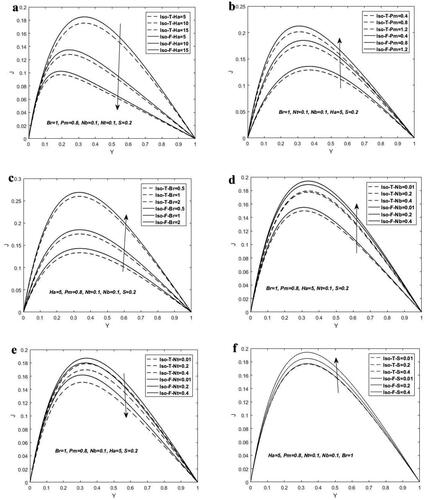
represents the implications of the embedded parameters on the temperature distribution for the unified boundary conditions. It is clear from that the fluid temperature enhances with increasing values of the Brownian motion parameter thermophoretic parameter
and heat source parameter
The effects of the thermophoretic and Brownian motion on temperature is inevitable due to the presence of nanoparticles in the channel as it enhances the temperature distribution. Furthermore, the external heat source applied at the surface of the channel boosts the fluid temperature and consequently reduce the rate of the heat transfer. It can also be seen that there is sharp increase in the temperature distribution when isoflux heating adopted whereas increasing the heat source is insignificant for the isothermal case. This phenomenon is obvious because, in isoflux heating, the temperature at the surface of the plates is maintained at constant heat flux unlike the isothermal heating where the temperature of the plate is maintained at a constant temperature. The impact of the active parameters on the rate of nanoparticles concentration is depicted in . It is obvious that the rate of the nanoparticles concentration enhances as Brownian motion and the thermophoretic parameter increase, this can be seen in . The heat source parameter
augment on the other slows the rate concentration as revealed in .
shows the performance of analytic solution (by perturbation) in comparison with the exact solution (by the method of undetermined coefficient) and numerical solution (by RKF45) for isothermal case in the absence of heat source. It is worthy to stress that the perturbation results are in good agreement with the exact and the numerical solutions. displays the impact of active parameters on the skin friction for fixed values of and
for isoflux boundary condition. The table revealed that the skin friction increases with heat source parameter
and the Buoyancy ratio
augment whereas it decreases with Hartmann number
and magnetic Prandtl number
Table 2. Effect of varying the active parameters on skin friction for
4. Conclusion
Magnetohydrodynamics natural convection in a vertical channel filled with nanofluid is studied. The combined effect of the induced magnetic field, and heat source temperature dependent is taken into consideration. Perturbation technique is adopted in solving the governing equation using mixed (isothermal and isoflux) boundary conditions. The influence of the prominent parameters on the velocity, the induced magnetic field, nanoparticles concentration, temperature distribution and skin friction for the two boundary conditions are fully presented using line graphs and tables. We found that:
The shear stress increases with the rise in
and
but decreases with other active parameters augment.
The induced magnetic field increases with increasing values of
and
but decreases with other active parameters.
The induced current density decreases with
and
but increases with other active parameters augment.
The temperature distribution increases with increasing values of
and S.
The nanoparticles diffusion increases with an increase in the values of
and
but decreases with S augment.
The skin friction decreases with Ha and Pm but increases with S and Br augment.
There is no significant effect of heat source on the velocity, temperature, induced magnetic field, induced current density and nanoparticles concentration when isothermal boundary condition is adopted.
| Nomenclature | ||
| B | = | induced magnetic field (Ampere(A) m−2) |
| = | magnetic field vector (Tesla (T)) | |
| T | = | temperature of the nanofluid (Kelvin (K)) |
| = | temperature (dimensionless) | |
| C | = | concentration (mol dm−3) |
| = | concentration (dimensionless) | |
| = | velocity vector (ms−1) | |
| U | = | vertical velocity (dimensionless) |
| h | = | distance between the two plates (m) |
| g | = | acceleration due to gravity (ms−2) |
| BD | = | Brownian diffusion coefficient (m2s−1) |
| S | = | heat source parameter (dimensionless) |
| Nt | = | thermophoretic parameter (dimensionless) |
| Nb | = | Brownian motion parameter (dimensionless) |
| Br | = | Brownian ratio parameter (dimensionless) |
| Ha | = | Hartmann number (dimensionless) |
| Pm | = | magnetic Prandtl number (dimensionless) |
| Greek symbols | ||
| = | fluid density (kg m−3) | |
| = | thermal expansion (K−1) | |
| = | dynamic viscosity of the nanofluid (kgm−1 s−1) | |
| = | electrical conductivity (Sm−1) | |
| Subscript | ||
| = | solid | |
| f | = | base |
| c | = | concentration |
Disclosure statement
No potential conflict of interest was reported by the authors.
References
- Alsabery, A. I., Gedik, E., Chamkha, A. J., & Hashim, I. (2019). Effects of two-phase nanofluid model and localized heat source/sink on natural convection in a square cavity with a solid circular cylinder. Computer Methods in Applied Mechanics and Engineering, 346, 952–981. doi:10.1016/j.cma.2018.09.041
- Azizian, R., Doroodchi, E., McKrell, T., Buongiorno, J., Hu, L. W., & Moghtaderi, B. (2014). Effect of magnetic field on laminar convective heat transfer of magnetite nanofluids. International Journal of Heat and Mass Transfer, 68, 94–109. doi:10.1016/j.ijheatmasstransfer.2013.09.011
- Bhattacharyya, K. (2011). Effects of radiation and heat source/sink on unsteady MHD boundary layer flow and heat transfer over a shrinking sheet with suction/injection. Frontiers of Chemical Science and Engineering, 5(3), 376–384. doi:10.1007/s11705-011-1121-0
- Bhatti, M. M., & Rashidi, M. M. (2016). Effects of thermo-diffusion and thermal radiation on Williamson nanofluid over a porous shrinking/stretching sheet. Journal of Molecular Liquids, 221, 567–573. doi:10.1016/j.molliq.2016.05.049
- Cao, L., Liu, D., Jiang, P., Shao, X., Zhou, Q., & Wang, Y. (2019). Multi-physics simulation of dendritic growth in magnetic field assisted solidification. International Journal of Heat and Mass Transfer, 144, 118673. doi:10.1016/j.ijheatmasstransfer.2019.118673
- Chen, M., He, Y., Zhu, J., & Wen, D. (2016). Investigating the collector efficiency of silver nanofluids based direct absorption solar collectors. Applied Energy, 181, 65–74. doi:10.1016/j.apenergy.2016.08.054
- Choi, S. U., & Eastman, J. A. (1995). Enhancing thermal conductivity of fluids with nanoparticles. Proceedings of the ASME International Mechanical Engineering Congress and Exposition, Argonne National Laboratory, IL.
- Feng, L., Shi, W.-Y., Shoji, E., Kubo, M., & Tsukada, T. (2019). Effects of vertical, horizontal and rotational magnetic fields on convection in an electromagnetically levitated droplet. International Journal of Heat and Mass Transfer, 130, 787–796. doi:10.1016/j.ijheatmasstransfer.2018.10.101
- Garoosi, F., Jahanshaloo, L., Rashidi, M. M., Badakhsh, A., & Ali, M. E. (2015). Numerical simulation of natural convection of the nanofluid in heat exchangers using a Buongiorno model. Journal of Applied Mathematics and Computing, 254, 183–203. doi:10.1016/j.amc.2014.12.116
- Hayat, T., Waqas, M., Khan, M. I., & Alsaedi, A. (2016). Analysis of thixotropic nanomaterial in a doubly stratified medium considering magnetic field effects. International Journal of Heat and Mass Transfer, 102, 1123–1129. doi:10.1016/j.ijheatmasstransfer.2016.06.090
- Ibrahim, W., & Makinde, O. D. (2013). The effect of double stratification on boundary-layer flow and heat transfer of nanofluid over a vertical plate. Computers & Fluids, 86, 433–441. doi:10.1016/j.compfluid.2013.07.029
- Kandelousi, M. S. (2014). Effect of spatially variable magnetic field on ferrofluid flow and heat transfer considering constant heat flux boundary condition. The European Physical Journal Plus, 129(11), 248. doi:10.1140/epjp/i2014-14248-2
- Kefayati, G. H. R. (2016). Simulation of double diffusive MHD (magnetohydrodynamic) natural convection and entropy generation in an open cavity filled with power-law fluids in the presence of Soret and Dufour effects (part II: Entropy generation). Energy, 107, 917–959. doi:10.1016/j.energy.2016.05.044
- Khan, W. A., & Makinde, O. D. (2014). MHD nanofluid bioconvection due to gyrotactic microorganisms over a convectively heat stretching sheet. International Journal of Thermal Sciences, 81, 118–124. doi:10.1016/j.ijthermalsci.2014.03.009
- Kumar, D., & Singh, A. K. (2015). Effect of induced magnetic field on natural convection with Newtonian heating/cooling in vertical concentric annuli. Procedia Engineering, 127, 568–574. doi:10.1016/j.proeng.2015.11.346
- Kumar, D., & Singh, A. K. (2016). Effects of heat source/sink and induced magnetic field on natural convective flow in vertical concentric annuli. Alexandria Engineering Journal, 55(4), 3125–3133. doi:10.1016/j.aej.2016.08.019
- Kumar, D., Singh, A. K., & Kumar, D. (2018). Effect of Hall current on the magnetohydrodynamic free convective flow between vertical walls with induced magnetic field. The European Physical Journal Plus, 133(5), 207.
- Kumar, D., Singh, A. K., & Kumar, D. (2020). Influence of heat source/sink on MHD flow between vertical alternate conducting walls with Hall effect. Physica A: Statistical Mechanics and Its Applications, 544, 123562. doi:10.1016/j.physa.2019.123562
- Kumar, D., Singh, A. K., & Sarveshanand, M. (2017). Effect of hall current and wall conductance on hydromagnetic natural convective flow between vertical walls. International Journal of Industrial Mathematics, 9(4), 289–299.
- Kumar, D., Singh, J., Tanwar, K., & Baleanu, D. (2019). A new fractional exothermic reactions model having constant heat source in porous media with power, exponential and Mittag-Leffler laws. International Journal of Heat and Mass Transfer, 138, 1222–1227. doi:10.1016/j.ijheatmasstransfer.2019.04.094
- Makinde, O. D., & Aziz, A. (2011). Boundary layer flow of a nanofluid past a stretching sheet with a convective boundary condition. International Journal of Thermal Sciences, 50(7), 1326–1332. doi:10.1016/j.ijthermalsci.2011.02.019
- Malvandi, A., & Ganji, D. D. (2015). Effects of nanoparticle migration and asymmetric heating on magnetohydrodynamic forced convection of alumina/water nanofluid in microchannels. European Journal of Mechanics – B/Fluids, 52, 169–184. doi:10.1016/j.euromechflu.2015.03.004
- Mehryan, S. A. M., Tahmasebi, A., Izadi, M., & Ghalambaz, M. (2020). Melting behavior of phase change materials in the presence of a non-uniform magnetic-field due to two variable magnetic sources. International Journal of Heat and Mass Transfer, 149, 119184. doi:10.1016/j.ijheatmasstransfer.2019.119184
- Mutuku, W. N., & Makinde, O. D. (2014). Hydromagnetic bioconvection of nanofluid over a permeable vertical plate due to gyrotactic microorganisms. Computers & Fluids, 95, 88–97. doi:10.1016/j.compfluid.2014.02.026
- Nguyen, T. K., Sheikholeslami, M., Jafaryar, M., Shafee, A., Li, Z., Chandra Mouli, K. V. V., & Tlili, I. (2020). Design of heat exchanger with combined turbulator. Journal of Thermal Analysis and Calorimetry, 139(1), 649–659. doi:10.1007/s10973-019-08401-7
- Qayyum, S., Khan, M. I., Hayat, T., & Alsaedi, A. (2017). A framework for nonlinear thermal radiation and homogeneous-heterogeneous reactions flow based on silver-water and copper-water nanoparticles: A numerical model for probable error. Results in Physics, 7, 1907–1914. doi:10.1016/j.rinp.2017.05.020
- Roy, N. C., Hossain, M. A., & Gorla, R. S. R. (2020). Natural convection in a cavity with trapezoidal heat sources mounted on a square cylinder. SN Applied Sciences, 2(2), 1–11. doi:10.1007/s42452-019-1927-9
- Rudraiah, N., Barron, R. M., Venkatachalappa, M., & Subbaraya, C. K. (1995). Effect of a magnetic field on free convection in a rectangular enclosure. International Journal of Engineering Science, 33(8), 1075–1084. doi:10.1016/0020-7225(94)00120-9
- Sarveshanand, &Singh, A. K. (2015). Magnetohydrodynamic free convection between vertical parallel porous plates in the presence of induced magnetic field. Springerplus, 4(1), 333. doi:10.1186/s40064-015-1097-1
- Sheikholeslami, M., Ashorynejad, H. R., & Rana, P. (2016). Lattice Boltzmann simulation of nanofluid heat transfer enhancement and entropy generation. Journal of Molecular Liquids, 214, 86–95. doi:10.1016/j.molliq.2015.11.052
- Sheikholeslami, M., Gorji-Bandpy, M., & Domairry, G. (2013). Free convection of nanofluid filled enclosure using lattice Boltzmann method (LBM). Applied Mathematics and Mechanics, 34(7), 833–846. doi:10.1007/s10483-013-1711-9
- Sheikholeslami, M., Gorji-Bandpy, M., & Ganji, D. D. (2014a). Lattice Boltzmann method for MHD natural convection heat transfer using nanofluid. Powder Technology., 254, 82–93. doi:10.1016/j.powtec.2013.12.054
- Sheikholeslami, M., Gorji-Bandpy, M., & Ganji, D. D. (2014b). MHD free convection in an eccentric semi-annulus filled with nanofluid. Journal of the Taiwan Institute of Chemical Engineers, 45(4), 1204–1216. doi:10.1016/j.jtice.2014.03.010
- Sheikholeslami, M., & Chamkha, A. J. (2016). Flow and convective heat transfer of a ferro-nanofluid in a double-sided lid-driven cavity with a wavy wall in the presence of a variable magnetic field. Numerical Heat Transfer Part A: Application, 69(10), 1186–1200. doi:10.1080/10407782.2015.1125709
- Sheikholeslami, M., & Ellahi, R. (2015). Three dimensional mesoscopic simulation of magnetic field effect on natural convection of nanofluid. International Journal of Heat and Mass Transfer, 89, 799–808. doi:10.1016/j.ijheatmasstransfer.2015.05.110
- Sheikholeslami, M., & Rokni, H. B. (2017). Nanofluid two phase model analysis in existence of induced magnetic field. International Journal of Heat and Mass Transfer, 107, 288–299. doi:10.1016/j.ijheatmasstransfer.2016.10.130
- Sheikholeslami, M., & Shehzad, S. A. (2017). Thermal radiation of ferrofluid in existence of Lorentz forces considering variable viscosity. International Journal of Heat and Mass Transfer, 109, 82–92. doi:10.1016/j.ijheatmasstransfer.2017.01.096
- Tlau, L., & Ontela, S. (2019). Entropy generation in MHD nanofluid flow with heat source/sink. SN Applied Sciences, 1(12), 1672. doi:10.1007/s42452-019-1733-4

